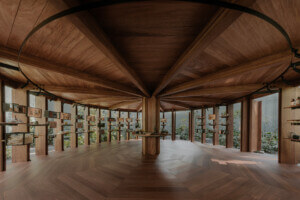The Architectural League of New York’s Emerging Voices award and lecture series highlights individuals and firms with distinct design “voices”, singling out those with the potential to go on to even greater heights.
2018 saw two rounds of judging; first by a panel of past Emerging Voices winners, and a second to pick the winners. The first-round jury included Virginia San Fratello, Sebastian Schmaling, Wonne Ickx, Lola Sheppard, Marcelo Spina, Carlos Jimenez, and Marlon Blackwell, as well as members of the second-round jury, Sunil Bald, Lisa Gray, Stella Betts, Jing Liu, Paul Makovsky, Tom Phifer, Chris Reed, and Billie Tsien.
AN profiled all of the emerging voices firms in our February print issue. Comunal: Taller de Arquitectura founders Jesica Amescua and Mariana Ordóñez Grajales will deliver their lecture on March 15, 2018, at the SVA Theatre in Manhattan.
Since establishing their practice in 2015, Mariana Ordóñez Grajales and Jesica Amescua, of Mexico City–based Comunal: Taller de Arquitectura, have continually worked to push the limits of their socially guided architectural practice and the architecture and building that result from it.
The practice combines academically minded research with materials engineering and community-led participatory design and construction to generate new forms of vernacular architecture in rural communities. “Our work begins with a social feasibility study,” Ordóñez explained. “We analyze and understand the capacity, willingness, and degree of organization that a community has to face difficulties. Then, we carry out the processes of research, social management, participatory design methodology, and finally, construction itself.”

For the architects, the true power of their profession lies in their ability to facilitate the culturally appropriate material improvement of these glossed-over rural communities, as evidenced by the firm’s work on a series of childbirth centers across Tenejapa Municipality, in the Mexican state of Chiapas. Comunal partnered with a group of local midwives to conceptualize a network of pitched clapboard structures that will help the delivery nurses formalize their practices and achieve their goal of eliminating infant and maternal mortality in the region.
Through built projects and academic research, the office also works to stave off the modernizing—and standardizing—effects of market forces and government regulation, which can produce alienating, short-lived structures and can often disincentivize the use of trusted materials like bamboo and thatch.
In a recent project, for Mexican social housing developer Infonavit, created in partnership with Mexico City-based architects Escobedo Soliz, Comunal helped create a courtyard home prototype built from these traditional materials. The vivendas are defined on one end by a home capped with a steeply raked roof that conceals a double-height interior volume containing a loft and the sleeping hammocks that are customary in the region. The courtyard complex is designed for passive ventilation and is erected out of running bonds of offset, buff-colored concrete block, with stone foundations. An indoor-outdoor kitchen sits opposite the lofted space, with a generous patio sandwiched in between.
Amescua said, “Vernacular architecture poses a close link and a constant dialogue with the territory, where the symbiosis between it and the inhabitant becomes evident not only in the form and functioning of the architectural objects but in the way in which elements are grouped.”
Working with traditional materials and construction techniques fueled Comunal’s approach for another social housing project, from 2013, with Unión de Cooperativas Tosepan Titataniske, a cooperative made up of indigenous communities in the state of Puebla. In this project, the designers pushed to incorporate bamboo construction in ways that would still allow regulators from the state to approve— and potentially fund—the project. For the development, Comunal and local partners developed a set of modular infill panels and roof trusses that sit on or between concrete-block walls and bamboo piers buttressed by intricate brickwork. The wall panels utilize bamboo and cementitious materials alternatively, depending on functional need, while the corrugated metal panel roof is designed to facilitate rainwater capture on site.
Lessons gleaned from the project were implemented in a 2016 effort in the same area that utilizes a primary set of concrete posts and beams for structure instead of bamboo. The social housing project was recognized in November 2016 with a silver medal in Mexico’s National Housing Commission’s First National Rural Housing Contest and has led to new work with the organization.















